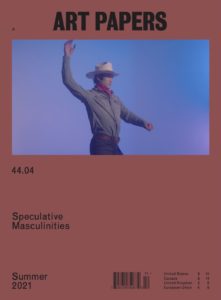Speculative Masculinities
Share:
This issue of ART PAPERS explores practices that reimagine or represent speculative, non-normative forms of masculinity. The issue explicitly centers LGBTQIA+ and men/masculine artists of color. These creators have long understood that masculinity has been constructed at the tangled intersection of heteronormativity, capitalist logic, and white supremacy. This issue seeks out practices that not only interrogate masculinity, but reimagine it: ones which move beyond critique toward propositions, reconfigurations, and liberatory ways of being masculine.
Earlier than many, bell hooks recognized that the social project of feminism should not turn a blind eye to patriarchy’s effects on the emotional and psychological lives of men. She understood that liberation for women was inexorably linked to the liberation of men and wrote, “If we cannot heal what we cannot feel, by supporting patriarchal culture that socializes men to deny feelings, we doom them to live in states of emotional numbness. We construct a culture where male pain can have no voice, where male hurt cannot be named or healed.” 
The seeds of this issue’s theme were sewn in 2017, when the #metoo hashtag went viral and the movement, which was founded in 2006 by survivor and activist Tarana Burke, erupted into the mainstream. Solidarity among survivors of sexual assault and harassment was bolstered as high-profile women and heretofore unknown women alike shared their stories en masse, side by side. The curtain was pulled back on what bell hooks influentially named “imperialist, capitalist, white supremacist patriarchy” and its systemic protection of powerful men who, from the workplace to the streets, serially prey upon women and femmes. The phrase toxic masculinity burst forth into common use, and for a time there was an upswelling of public awareness and accountability.
As I started having more conversations with men in my life about toxic masculinity, I found myself reflecting on a childhood memory. In the 1980s, a marketing trend emerged to divide the world of toys, especially art supplies, and most notably markers, into two opposing camps: “toxic” and “non-toxic.” With the invention of “non-toxic” markers, those without this designation were suddenly exposed as always having been harmful. A new imperative arose: to become guarded from some, while simultaneously letting down that guard—for others. I wondered about a non-toxic masculinity, one that would be safer to get on your skin, or in your mouth. What kinds of masculinity were safe to let inside? Of course, this toxic/non-toxic binary is, itself, limiting, as is any notion of “men” as a monolithic group that one is either “inside” or “outside” of. So many tools of deconstruction rely, unfortunately, on such reductive models as these. Perhaps the more important question is this: How do we move from critique toward proposition?
This issue seeks to acknowledge past and present artistic interventions into tropes and stereotypes of masculinity, as well as ones that rupture narrowly constrained spaces of expression afforded to men in normative social spaces. It is also important to note that this exploration of masculinity is not intended to reinforce a gender binary, but rather to recognize that articulations of masculinity are manifested within or exert external influence upon people of all gender expressions.
Each contribution addresses how artistic practices have prized open space and held it for speculative forms of masculinity, often by using strategies that emphasize the generative power of intersectional thinking. In “Blue Cripistemologies: In and Around Derek Jarman,” Christopher Robert Jones makes a case for reading Jarman’s iconic film Blue as a foundational work of Queer/Crip interiority. Re’al Christian speaks with Kenneth Tam, in “The Silence We Hold Between Our Bodies,” about his recent work Silent Spikes; the entwined mythologies of American Cowboys with Chinese laborers on the Transcontinental Railroad; and the intimacy—and intensity—of male coming-of-age rituals. In “Yo soy mi padre,” Joseph Shaikewitz explores Chilean artist Carlos Leppe’s use of gender transgression as a means of resistance and escape from the oppression of dictatorship.
In “Infectious Materials, Molecular Memories,” Sasha Cordingley talks with Jes Fan about some of the chemical foundations upon which contemporary identity categories are ostensibly built—testosterone, estrogen, melanin—and exposing their complex biopolitical histories in his work. In “Operating Along Desire,” Tyra A. Seals speaks with Derrick Woods-Morrow about deconstructing masculinity, moving through feeling, and interventions on the sartorial codes of male-identified bodies. This issue’s glossary entry, by Shehab Awad, takes up the term autosexuality (n.) and, in the process, offers a parable of self-discovery and acceptance. The reviews section visits exhibitions in Atlanta, New York, and Zurich, as well as the pages of a recent collection of Joan Didion’s writing.
The asterisk, in its standard use as a punctuation mark, draws attention to displaced information, marks an omission, or points to a disclaimer. Here, do / you, a project by writer and video artist Jason Lipeles, explores questions of past and present, and of love in isolation and through connection, and relies heavily upon the asterisk’s potential. This project is also expanded to include an accompanying video work by Lipeles on ARTPAPERS.org.
ERRATUM:
Finally, I must address and correct two errors in our Spring 2021 issue. We mistakenly omitted the footnotes in Mathilde Walker-Billaud’s essay “Inaudibility: Krista Belle Stewart’s Sonic Repatriation of Knowledge.” Walker-Billaud’s complete footnotes can be found in the online version of the text. We also left out the photo credit for the documentation of Stacy Lynn Waddell’s work in her artist project, which should have acknowledged the close collaboration between Waddell and Christopher Ciccone Photography. This omission has also been corrected in the online version of the project.
Sarah Higgins
Editor + Artistic Director
editor@artpapers.org